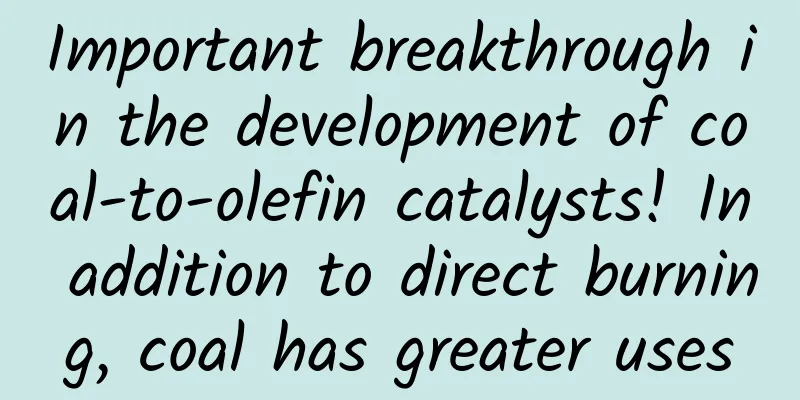Important breakthrough in the development of coal-to-olefin catalysts! In addition to direct burning, coal has greater uses

|
Produced by: Science Popularization China Author: Denovo Producer: China Science Expo Energy plays a vital role in the development of human society. Whether it is the mobile phones, electrical appliances, cars in our daily lives, or the aircraft engines and rocket thrusters in industrial production, they are inseparable from the supply of energy. In my country, the main fossil energy source is still coal, accounting for nearly 70%, oil accounts for about 20%, and natural gas accounts for only 1% to 2%. The current situation is that the domestic demand for energy is greater than the supply, especially the demand for liquid energy (such as olefins). Olefins play an important role in many fields, including as fuel, chemical raw materials, fertilizer raw materials, and intermediates for chemicals. Therefore, the development of new technologies for the production of olefins is of great value to my country's economic and social development. Scientists have raised an interesting question: Can we use our richer coal to produce liquid energy such as olefins? Chinese researchers have already started to practice this idea. They first convert coal into synthesis gas, and then further convert the synthesis gas into liquid energy such as gasoline, diesel and aromatics through the Fischer-Tropsch reaction. 3D model of ethylene (the simplest olefin) (Image source: Wikipedia) Fischer-Tropsch synthesis: the “magic kitchen” in the chemical industry What is the "syngas" we mentioned above? In fact, it is a mixture of carbon monoxide (CO) and hydrogen (H2). How to make this mixture? Usually, we will use hydrocarbons such as coal, oil, and even biomass with oxidants (such as oxygen and water vapor) for partial oxidation and water-gas shift reactions to generate synthesis gas. This special gas has a wide range of applications in the chemical industry and is an important raw material in the process of synthesizing liquid fuels. These important processes include Fischer-Tropsch synthesis. What is Fischer-Tropsch synthesis? Fischer-Tropsch synthesis is a unique chemical process whose main purpose is to convert synthesis gas into liquid fuels and other valuable chemicals. This process was originally pioneered by two German chemists, Franz Fischer and Hans Tropsch, in the 1920s. We can illustrate Fischer-Tropsch synthesis with a more lifelike example: it can be imagined as a "magic kitchen". (Photo source: veer photo gallery) In this kitchen, our synthesis gas is the "ingredients". After a series of chemical reactions (under the action of catalysts), we can make "delicious food" - liquid fuel. This "magic kitchen" can transform simple ingredients into a variety of useful products. For example, we can imagine carbon monoxide (CO) as tomatoes and hydrogen (H2) as eggs. Using different amounts of tomatoes and eggs, through a series of different cooking methods, they can be turned into scrambled eggs, tomato and egg soup, or even tomato and egg pancakes. Fischer-Tropsch synthesis plays an important role in energy diversification and efficient resource utilization. Especially in my country, where the resource situation is rich in coal, short of oil and little gas, this technology can convert our abundant local coal, biomass and other resources into liquid fuel, reduce our dependence on external oil, and further improve our energy security. Therefore, this reaction has very important strategic significance. Catalyst: A seesaw that is hard to break through Now that we understand the importance of the Fischer-Tropsch synthesis reaction, let’s take a look at the most important work done by scientists – improving catalysts. A catalyst in a chemical reaction is a substance that promotes the reaction. It can accelerate the reaction rate, but it does not participate in the reaction itself. In the Fischer-Tropsch reaction, the type of catalyst directly affects the type and distribution of the products. Not only the Fischer-Tropsch reaction, in fact, in the chemical industry, more than 85% of chemical reactions rely on catalysts to increase the reaction rate. When we are dealing with some complex reactions that can produce multiple products, we hope to obtain as many and pure target products as possible, but the activity and selectivity (selectivity represents the uniqueness of the product) of most catalyst systems will have a "seesaw effect". At the two ends of the seesaw, one end is the activity of the reaction, and the other end is the selectivity of the reaction. If the activity increases, the selectivity will decrease, which will lead to a low yield of the target product. (Photo source: veer photo gallery) After nearly 90 years of development, the selectivity of low-carbon olefin products in the system of synthesizing low-carbon olefins from syngas has been difficult to break through the theoretical limit (58%), and the catalytic system has a serious seesaw effect. Therefore, how to break through the limit and break the "seesaw" effect has always been a long-term concern of scientists in this field. First-generation OXZEO catalyst: pushing the limits How to break through the theoretical limits of low-carbon olefin product selectivity? Academician Bao Xinhe and Researcher Pan Xiulian's team from the Dalian Institute of Chemical Physics of the Chinese Academy of Sciences came up with an ingenious idea: changing the active components in the catalyst from traditional metals or metal carbides to a composite catalyst of metal oxides and molecular sieves - OXZEO. The molecular sieve is a special zeolite with microscopically uniform pores and neatly arranged holes. It acts like a molecular-level sieve that can screen molecules of different sizes and shapes. In the OXZEO system, carbon monoxide molecules are adsorbed onto the surface of metal oxides, and then the CO bonds are "cut" to form oxygen atoms and carbon atoms on the surface; H2 in the gas phase reacts with the surface carbon atoms to form hydrocarbon intermediates, which then enter the pores of the molecular sieve that can "sieve molecules" and begin to grow in a chain of carbon atoms. This process cleverly utilizes the restrictive nature of the molecular sieve pores, and by adjusting the pore size of the molecular sieve, the types of reaction products are precisely controlled, thus breaking the selectivity limit of synthesizing low-carbon olefins from synthesis gas. The reaction process of syngas to olefins catalyzed by OXZEO (Image source: Science magazine, 2016) This breakthrough research result enables the selectivity of low-carbon olefins to reach 80% when the carbon monoxide conversion rate reaches 17%, successfully breaking through the theoretical limit of 58%. At the same time, this catalytic system abandons the traditional high water consumption and high energy consumption path, subverts the Fischer-Tropsch synthesis route invented by German scientists in the 1920s that has been followed by coal chemical industry, and in principle creates a new way to convert coal into synthesis gas in one step with low water consumption (no water circulation in the reaction, no wastewater discharge). The research results were published in the journal Science in 2016. By 2020, the team completed an industrial trial with an annual output of 1,000 tons of light-carbon olefins in the factory, confirming the feasibility of the process in scientific principles and practical processes, further promoting the development of light-carbon olefin product preparation technology, and providing more reliable and efficient technical means for the production of green energy and chemicals. Next-generation OXZEO catalyst: Going beyond itself The first generation of OXZEO catalyst broke the theoretical limit of 58% for low-carbon olefins for hundreds of years, but the conversion rate of the reactant CO was only 17%. In order to solve the seesaw problem of activity and selectivity in the syngas-to-olefins reaction system, the team of Academician Bao Xinhe continued to conduct in-depth research, striving to develop catalysts that can simultaneously improve activity and selectivity. They found that the root cause of the limitation of the seesaw effect is that the current molecular sieves not only catalyze the main reaction (carbon-carbon "hand in hand" conversion to generate light olefins), but also catalyze two side reactions (light olefins combine with other substances to generate low-value alkanes, and light olefin groups "hand in hand" to generate large molecular olefins). This common active center is like the fulcrum of the "seesaw". Once the conversion rate increases, the selectivity will decrease accordingly, making it difficult to increase the conversion rate and selectivity at the same time, ultimately resulting in a low yield of light olefins. To solve this problem, they optimized the first generation OXZEO catalyst. Based on the original molecular sieve, they prepared a microporous molecular sieve based on metal germanium ions (GeAPO-18). This new type of molecular sieve weakens the acidity, effectively inhibits the polymerization of low-carbon olefins to form macromolecules, and the possibility of combining with other atoms, achieving a complete separation of active centers and reducing the occurrence of side reactions. This optimization is like transforming the original "seesaw" model with one fulcrum into two independent "wings", so that the two processes of the formation of the initial reaction intermediate and the subsequent chain growth of carbon atoms occur at independent sites, allowing the reaction to "fly freely". Under optimized reaction conditions, this new catalyst maintained a low-carbon olefin selectivity greater than 80% (up to 83%), while achieving a single-pass CO conversion rate of 85%, achieving a low-carbon olefin yield (yield refers to the ratio of actual output to theoretical output) of 48%, the international best level, more than double that of the first-generation OXZEO catalyst. This major breakthrough was published online in the journal Science on the 19th of this month. Activity-selectivity trade-off in OXZEO syngas to light olefins process (Image source: Science magazine, 2023) Academician Bao Xinhe and his team have successfully expanded the design thinking of OXZEO catalysts and initially built an innovative technology platform for direct conversion of coal to syngas. They have achieved the directional synthesis of a series of high-value chemicals and fuels, leading the new development direction of water-saving, energy-saving and efficient coal chemical industry. This groundbreaking achievement completely overturned the Fischer-Tropsch route that the coal chemical industry has adhered to for more than 90 years, and successfully solved the "seesaw" problem of the difficulty in simultaneously improving activity and selectivity in traditional catalytic reactions. This reaction process will not only significantly reduce the water and energy consumption of coal chemical industry, but also be praised by the industry as a "milestone breakthrough" in the field of coal conversion. Conclusion This new process will undoubtedly have a profound impact on the development and application of coal and natural gas in the chemical industry. It has opened up a new chapter in coal chemical industry and promoted the development of the entire field in a more efficient, green and sustainable direction. Chinese scientists have been on the road to revitalize the energy field. |
Recommend
How to increase popularity through Kuaishou live streaming? A few tips will help you realize your dream of becoming an internet celebrity!
Professional Douyin and Kuaishou likes-boosting p...
How to choose brand Xiaohongshu KOL promotion?
Introduction: As the commercial value of Xiaohong...
Lava tubes under the moon
The moon is the closest extraterrestrial body to ...
China Automobile Dealers Association: Passenger car new four modernizations index is 64.2 in October 2020
The Passenger Car New Four Modernizations Index, ...
AMIRO Small Black Mirror VS Tmall Genie QUEEN Beauty Mirror: Which one is the "magic mirror" that makes you prettier than Snow White?
Loving beauty has always been a girl’s nature. Wi...
How to make a mini program for a clothing store in Guangzhou? How to build a clothing WeChat applet?
The Internet has undergone a development trend in...
How to promote and attract traffic to Xianyu? The practical method of attracting traffic to Xianyu with coupons is revealed!
Xianyu is now a traffic-generating platform that ...
CNBC: Ford's U.S. sales in May 2022 fell only 4.5% from the same period last year
Ford Motor's U.S. sales in May fell just 4.5%...
How to write good copy? Learn these 17 methods!
1. First you need to digest the information about...
Street stall fast-moving consumer goods can be understood from two aspects
During this period, whether in cities or rural ar...
iOS 7.1.1 surprise new changes: exciting
In addition to fixing bugs and Touch ID, iOS 7.1.1...
People who often eat midnight snacks must be careful about this problem~
Audit expert: Wu Xi Associate Chief Physician, De...
Amazon's new wave of machine learning: powerful and actionable
[51CTO.com Quick Translation] Professional users ...
Daokun "Taobao Blue Ocean Profitable Non-standard Product Selection Ideas" Daokun Taobao Internal Training Club [2021], worth 4980 yuan Baidu Cloud Download
Dao Kun Taobao Blue Ocean Internal Training is a ...
Kunming Baidu Ai Procurement customer service phone number, how much does Baidu Ai Procurement promotion cost?
Baidu Aicaigou is a B2B e-commerce platform that ...









